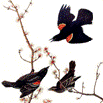Wildlife Damage Management, Internet Center for
Document Type
Article
Date of this Version
September 1968
Abstract
Ecological studies are being carried out by Denver Wildlife Research Center personnel on starlings (Sturnus vulgaris) and blackbirds as part of a research program to alleviate damage by these species. The objectives are to determine the breeding and wintering areas, migratory routes, local movement patterns, and turnover rates of problem populations. Knowledge about the movement of problem birds is essential for determining those points in their daily and seasonal movement cycles where they are likely to be more vulnerable to control. Banding and marking programs are presently the primary means of gathering movement data. Since 1960, Denver personnel and cooperators have banded nearly 200,000 starlings and blackbirds in Arizona, Nevada, California, Colorado, Oregon, South Dakota, and North Dakota. About 60,000 of these birds were also color-tagged with leg streamers to increase the normally low recovery rate of starlings and blackbirds and to provide data on the feeding, movement, and roosting patterns of local populations. The most successful and efficient trapping technique used to capture these birds was the use of bait traps such as the modified Australian crow trap and the decoy trap used successfully by Patuxent Research Center biologists. Use of long-handled dip-nets in frozen marsh roosts at night and cannon nets and chemical soporifics in feeding and preroosting areas also resulted in thousands of banded birds. Information from banded and tagged birds, coupled with observations of flock movement and behavior, has provided a basis for damage control research on the starling-feedlot problem in Colorado and on the blackbird-corn damage problem in South Dakota.


